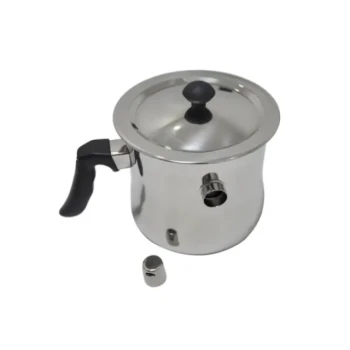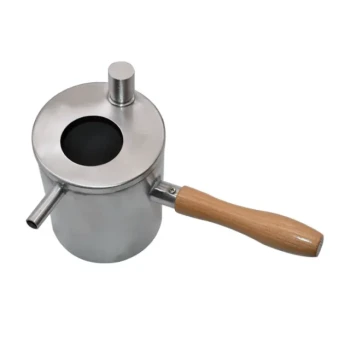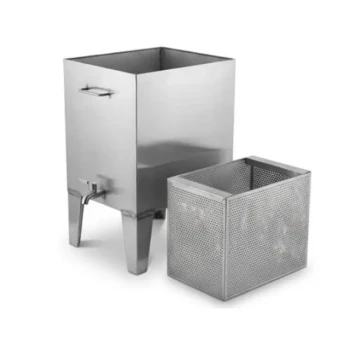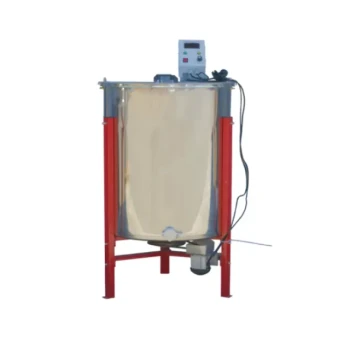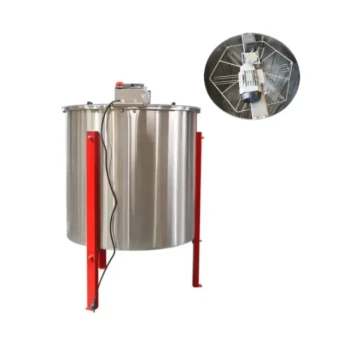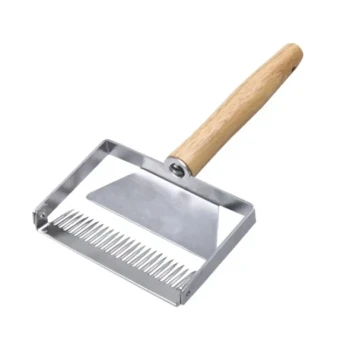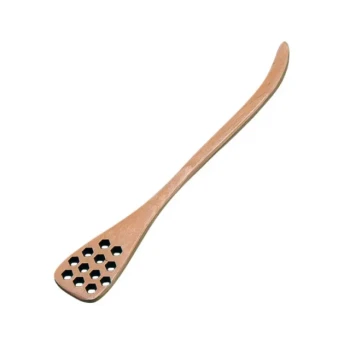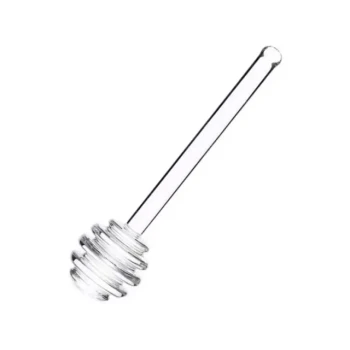To separate honey from wax cappings, the most common methods involve draining the honey through gravity, using a specialized melter to separate them with low heat, or rinsing the cappings with water to recover the remaining sugars. The method you choose depends on the scale of your operation and how you prioritize honey quality versus speed and efficiency.
The core challenge is choosing a separation method that aligns with your goals. You must balance the desire for pure, raw honey against the efficiency of heat-based separation or the total-yield approach of rinsing.
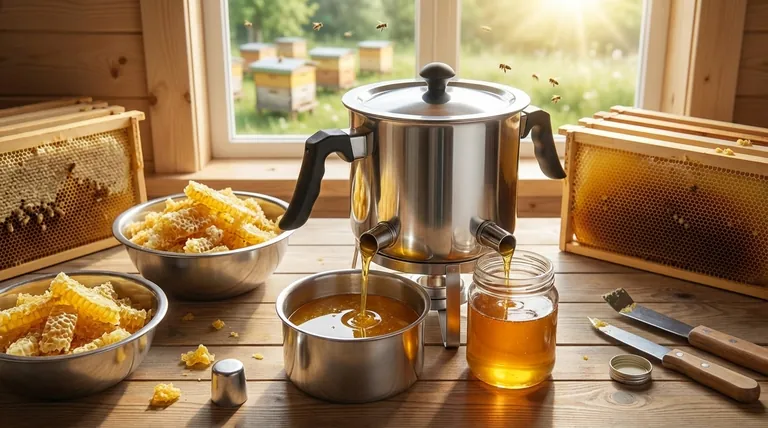
The Primary Separation Methods
Wax cappings, the thin beeswax layer that seals a honeycomb cell, are sliced off before honey extraction. This process leaves you with a sticky mixture of wax and a significant amount of high-quality honey that needs to be salvaged.
Method 1: Draining and Straining
This is the simplest, most common method for small-scale beekeepers, as it requires no special equipment and preserves the honey's raw quality.
The cappings are placed in a container with a mesh or screen bottom, such as a dedicated uncapping tank or a simple bucket with a honey gate and a strainer.
Gravity slowly pulls the honey down, separating it from the wax. This can take several hours to a few days, and gently stirring the cappings can help release more honey.
Method 2: Using a Cappings Melter
For larger operations, a dedicated uncapping melter provides a fast and efficient solution. These devices use low, controlled heat.
The heat melts the wax, which is lighter than honey and floats to the top. The denser honey sinks to the bottom.
Separate spigots or outlets then allow you to drain the honey and the liquid beeswax independently, achieving a clean separation in a single step.
Method 3: Rinsing with Water
This method focuses on recovering every last bit of sugar from the wax, ensuring zero waste.
After a preliminary draining, the wax cappings are rinsed with cool or lukewarm water. The water dissolves the remaining honey.
This creates a honey-water solution, not pure honey. This mixture is excellent for feeding back to the bees or for use in fermentation, such as making mead. The wax is left clean and ready for rendering.
Understanding the Trade-offs
No single method is perfect for every situation. Your choice has direct consequences for the final quality of both your honey and your wax.
Heat vs. Honey Quality
The primary trade-off involves heat. While melters are highly efficient, applying heat can darken the honey's color and break down its delicate enzymes and aromatic compounds.
To be sold as "raw," honey should not be heated significantly. Therefore, the gravity draining method is superior for preserving raw honey's integrity.
Purity vs. Total Yield
Rinsing cappings with water will absolutely maximize your sugar yield. However, the resulting product cannot be bottled and sold as pure honey.
You gain a useful secondary product (honey-water) at the cost of sacrificing the purity of the honey that was left in the cappings.
Equipment vs. Effort
Draining is low-cost but slow and can be messy. Melters require a significant upfront investment but streamline the process considerably, saving time and labor in the long run.
Making the Right Choice for Your Goal
Select your method based on what you value most in your beekeeping operation.
- If your primary focus is preserving raw honey quality: Use the gravity draining and straining method to ensure the honey is never exposed to heat.
- If your primary focus is speed and efficiency for a larger harvest: Invest in a dedicated uncapping melter for a streamlined, continuous workflow.
- If your primary focus is maximizing yield with zero waste: Drain the cappings first, then rinse them with water to create a valuable secondary product for feeding bees or making mead.
Choosing the right separation technique ensures you capture the full value of your harvest, from pure, raw honey to clean, rendered beeswax.
Summary Table:
| Method | Best For | Key Advantage | Key Trade-off |
|---|---|---|---|
| Draining & Straining | Small-scale beekeepers | Preserves raw honey quality | Slow process, requires patience |
| Cappings Melter | Commercial apiaries | Fast, efficient, and clean | Heat can affect honey's raw quality |
| Rinsing with Water | Maximizing total yield | Zero waste, creates feed for bees | Produces honey-water, not pure honey |
Maximize the value of your harvest with the right equipment from HONESTBEE.
As a trusted supplier for commercial apiaries and beekeeping equipment distributors, we understand the critical balance between honey quality, operational efficiency, and yield. Whether you need durable uncapping tanks for gentle gravity draining or high-capacity cappings melters for fast processing, our wholesale-focused operations provide the reliable equipment your business depends on.
Let us help you optimize your post-harvest workflow. Contact our team today to discuss the best solutions for your apiary's scale and goals.
Visual Guide
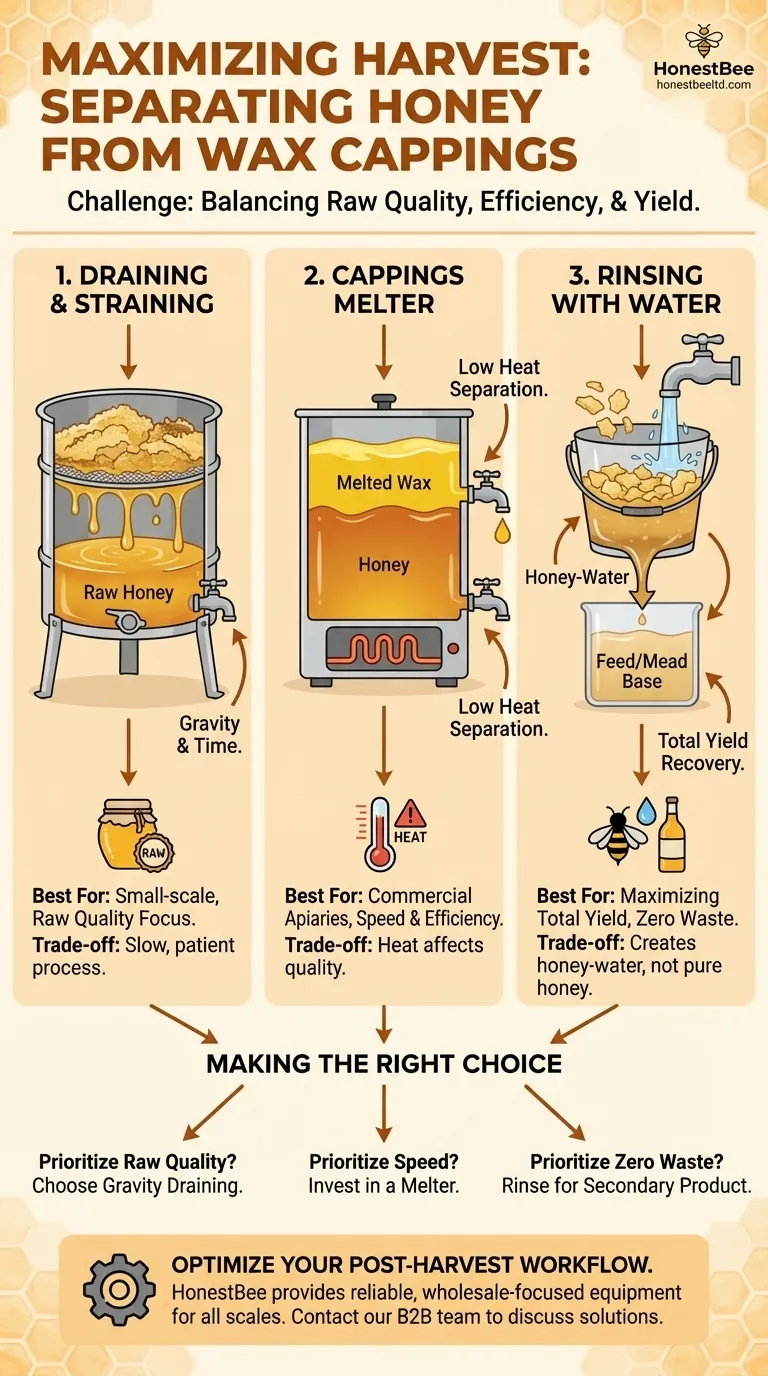
Related Products
- Beeswax Melter for Candle Making Honey Bee Wax Melter
- Honey Wax Separating Wax Press with Metal Screw Wax Separator Machine
- Professional Stainless Steel Wax Melter for Beekeeping and Crafts
- Stainless Steel Honey Press Wax Press with Tank
- HONESTBEE 3-Frame Manual Acrylic Honey Extractor
People Also Ask
- What are the main types of wax melters? Choose the Right Heating Method for Your Needs
- How does a steam wax melter work? A Fast, Efficient Method for High-Quality Wax
- What is the flashpoint of beeswax? Essential Safety and Quality Tips for Beekeepers
- What do you use a wax melter for? From Home Fragrance to Professional Beekeeping
- What is the best way to melt beeswax for candles? The Safest Method for Professional Results
